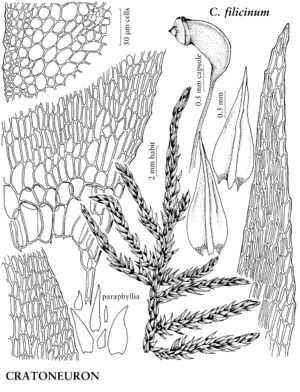Cratoneuron
Cat. Musc., 21. 1867.
| Taxon | Illustrator ⠉ | |
|---|---|---|
 | Cratoneuron filicinum | Patricia M. Eckel |
Plants medium-sized, green, yellowish, or rarely brownish. Stems pinnate or irregularly branched; hyalodermis absent, central strand present; paraphyllia few-to-many, rarely absent, lanceolate; rhizoids or rhizoid initials on stem or abaxial costa insertion, often forming tomentum, usually strongly branched, smooth; axillary hair distal cells 1 or 2, hyaline. Stem-leaves not recurved or squarrose, straight or falcate, narrowly to broadly triangular or rounded-triangular, sometimes ovate, not plicate, longer than 1 mm; base decurrent; margins plane or near base slightly recurved, denticulate or serrulate almost throughout, limbidia absent; apex acuminate, acumen plane or furrowed; costa strong, single, usually percurrent or excurrent, sometimes ending well before apex; alar cells differentiated, strongly inflated, hyaline, region well defined, transversely triangular; medial laminal cells elongate-hexagonal, short-rectangular, rectangular, short-linear, or rarely linear, smooth; marginal cells 1-stratose. Sexual condition dioicous. Capsule horizontal, cylindric, curved; peristome perfect; exostome margins slightly dentate distally; endostome cilia 2 or 3, well developed, nodose. Spores 14–21 (–25) µm.
Distribution
North America, South America, Eurasia, Africa, Atlantic Islands, Pacific Islands (New Zealand)
Discussion
Species 2 (1 in the flora).
Cratoneuron grows in slightly or strongly calcareous habitats that are at least periodically wet; plants have a strong leaf costa, relatively short, smooth laminal cells, and mostly lanceolate and leaflike paraphyllia. The differences between Cratoneuron and 2. Palustriella are described under the latter.
Selected References
None.
Lower Taxa
"narrower" is not a number.